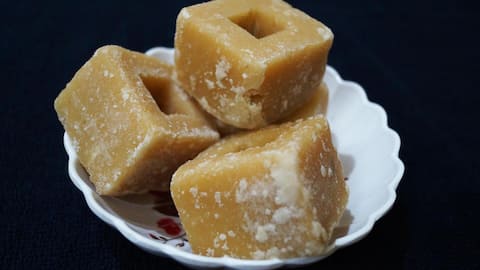Smart tips to know if your jaggery is pure
What's the story
Jaggery, a natural sweetener, is savored widely during winter. It has become a popular healthy alternative to refined sugar.
A staple in India, jaggery's vitamins and minerals make it healthier than white sugar.
However, not every jaggery you get in the market is pure. To help with the right quality check to do on the jaggery, we reached out to celebrity chef Renu Dalal.
Color
Check for color
The color of the jaggery plays a crucial role in identifying purity. Various types of jaggery are available in the market that vary in color.
The jaggery should ideally be a dark brown color. A yellowish color could be a sign of chemical treatment.
Chemicals like sodium hydrosulfite are often used to give jaggery a vivid yellowish-white appearance to make it visually appealing.
Taste
Taste test
Real jaggery has a distinct taste. It should typically have an earthy, sweet, rich taste depending on the type of jaggery.
If instead it tastes unusually sweet or lacks the characteristic molasses flavor, it might be adulterated.
Some adulterated jaggery also tastes salty. Saltiness also indicates the staleness of jaggery. Generally, the older the jaggery is, the saltier it will be.
Soluble
Water test
Unadultersted jaggery should be soluble in water. Chalk powder is often combined with some jaggery to boost its volume.
To test this, dissolve a small amount of jaggery in water. If it leaves behind a residue or substance or appears creamy, then it is adulterated.
When jaggery is fully dissolved in water, it should have a brown, glossy, and translucent appearance.
Appearance
Presence of crystals
Observe the surface of the jaggery carefully. See if it has any crystals.
The presence of crystals suggests that additional steps may have been taken to sweeten the jaggery.
Compared to refined sugar, jaggery has less sucrose, which makes it less sweet. As a result, crystals of refined sugar are added to jaggery to increase its sweetness.
